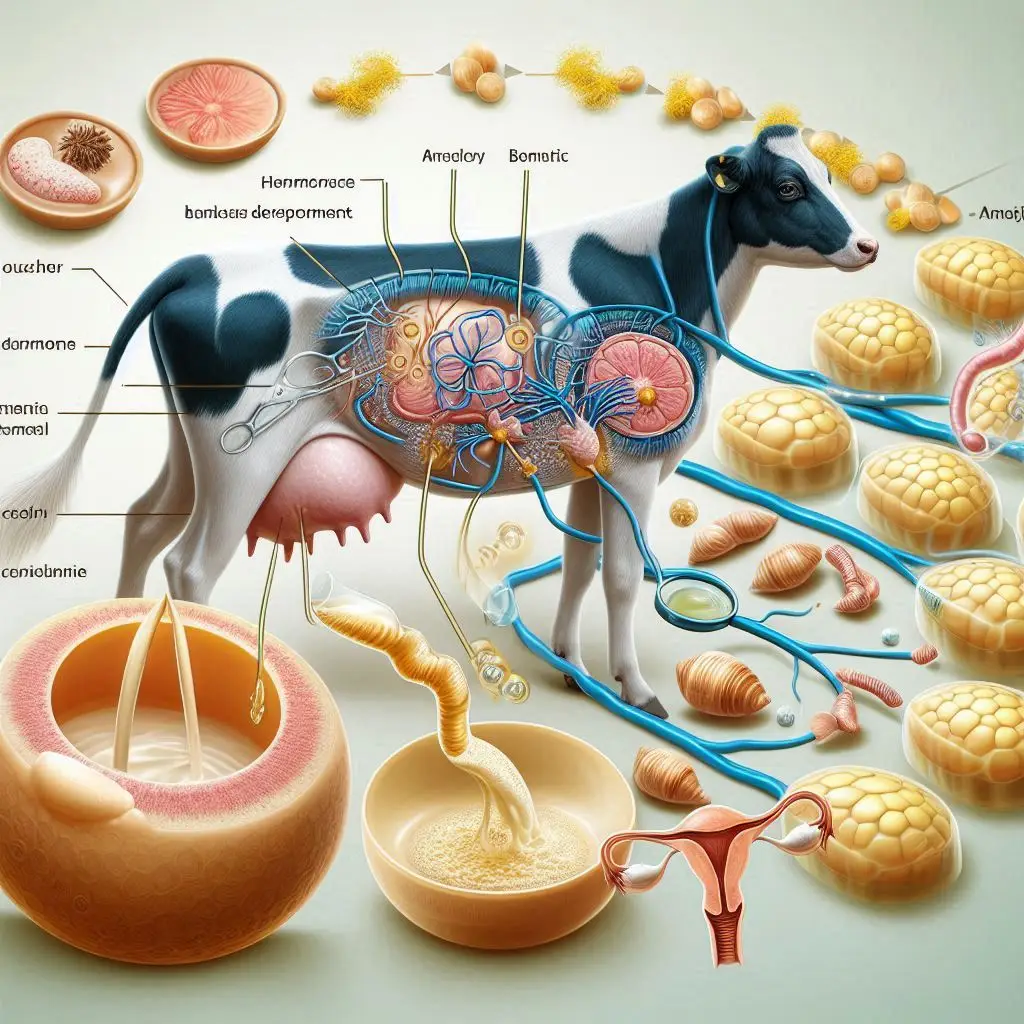Hormonal Control of Mammary Development and Lactation

Introduction
Lactation is a vital biological process that ensures the survival of mammalian offspring by providing essential nutrients through breast milk. The mammary gland, a dynamic organ, undergoes significant changes throughout a female’s life, particularly during puberty, pregnancy, and lactation. This article delves into the hormonal control of mammary development, milk secretion, and milk ejection, highlighting the intricate interplay of hormones that facilitate these processes.
1. Anatomy of the Mammary Gland
The mammary gland consists of glandular tissue, ducts, and connective tissue, structured to support milk production and delivery. Key components include:
- Alveoli: Small sacs where milk is produced.
- Ducts: Channels that transport milk from the alveoli to the nipple.
- Myoepithelial Cells: Muscle-like cells that contract to help eject milk.
Understanding the anatomy is crucial for comprehending how hormones affect mammary function.
2. Hormonal Regulation of Mammary Development
2.1 Puberty and Mammary Development
During puberty, the mammary gland undergoes significant development due to hormonal changes:
- Estrogen: Promotes ductal growth and branching.
- Progesterone: Stimulates the formation of lobules and alveoli.
- Growth Hormone (GH): Enhances overall growth and development of mammary tissue.
2.2 Pregnancy and Mammary Development
Pregnancy triggers profound changes in the mammary glands, preparing them for lactation:
- Estrogen and Progesterone: Levels rise significantly, promoting the growth of mammary tissue and the differentiation of alveolar cells.
- Placental Lactogen: A hormone produced by the placenta that further stimulates mammary growth.
2.3 Lactogenesis
Lactogenesis is the initiation of milk production, occurring in two stages:
- Stage I: Begins mid-pregnancy, where the mammary glands prepare for milk secretion.
- Stage II: Occurs after childbirth, triggered by the withdrawal of progesterone and the increase in prolactin levels.
3. Hormonal Control of Milk Secretion
3.1 Prolactin
Prolactin is the primary hormone responsible for milk production:
- Secretion: Produced by the anterior pituitary gland, its levels rise during and after pregnancy.
- Action: Stimulates alveolar cells to synthesize milk components, such as lactose and fats.
3.2 Oxytocin
Oxytocin plays a crucial role in milk ejection:
- Release: Triggered by suckling, it causes contraction of myoepithelial cells surrounding the alveoli.
- Function: Facilitates the movement of milk through the ducts to the nipple.
3.3 Feedback Mechanisms
The regulation of milk production also involves feedback mechanisms:
- Feedback Inhibitor of Lactation (FIL): A polypeptide in breast milk that inhibits milk production when milk is not removed, ensuring balance within the mammary glands.
4. Milk Ejection Reflex
The milk ejection reflex, or letdown reflex, is a neuroendocrine response essential for breastfeeding:
- Suckling Stimulus: Sensory signals from the nipple to the brain trigger the release of oxytocin.
- Milk Ejection: Oxytocin causes the contraction of myoepithelial cells, ejecting milk into the ducts.
5. Factors Influencing Lactation
5.1 Nutritional Status
The mother’s nutritional status significantly impacts milk production and quality:
- Energy and Nutrient Availability: Adequate nutrition supports the metabolic demands of lactation.
5.2 Psychological Factors
Emotional well-being can influence lactation:
- Stress and Relaxation: Stress can inhibit prolactin release, while relaxation promotes milk production.
5.3 Environmental Factors
External factors can also affect lactation:
- Support Systems: Presence of supportive family and healthcare providers can enhance breastfeeding success.
6. Conclusion
The hormonal control of mammary development, milk secretion, and ejection is a complex and finely tuned process essential for successful lactation. Understanding these mechanisms not only aids in promoting breastfeeding but also highlights the importance of hormonal balance in maternal health.
For more pearls of Vets Wisdom:





Responses